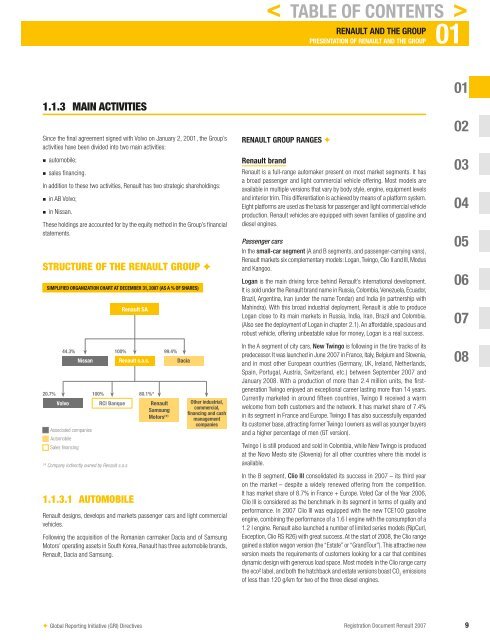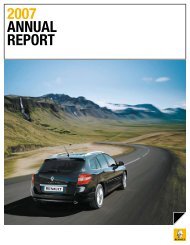2007 Interactive Registration Document - Renault
2007 Interactive Registration Document - Renault
2007 Interactive Registration Document - Renault
You also want an ePaper? Increase the reach of your titles
YUMPU automatically turns print PDFs into web optimized ePapers that Google loves.
1.1.3 MAIN ACTIVITIES<br />
Since the fi nal agreement signed with Volvo on January 2, 2001, the Group’s<br />
activities have been divided into two main activities:<br />
n<br />
n<br />
a utomobile;<br />
s ales fi nancing.<br />
In addition to these two activities, <strong>Renault</strong> has two strategic shareholdings:<br />
n<br />
n<br />
in AB Volvo;<br />
in Nissan.<br />
These holdings are accounted for by the equity method in the Group’s fi nancial<br />
statements.<br />
STRUCTURE OF THE RENAULT GROUP ✦<br />
SIMPLIFIED ORGANIZATION CHART AT DECEMBER 31, <strong>2007</strong> (AS A % OF SHARES)<br />
20.7%<br />
44.3% 100%<br />
Nissan <strong>Renault</strong> s.a.s.<br />
Volvo<br />
Associated companies<br />
Automobile<br />
Sales financing<br />
100%<br />
RCI Banque<br />
( * ) Company indirectly owned by <strong>Renault</strong> s.a.s.<br />
1.1.3.1 AUTOMOBILE<br />
<strong>Renault</strong> SA<br />
80.1%*<br />
<strong>Renault</strong><br />
Samsung<br />
Motors ( * )<br />
99.4%<br />
Dacia<br />
Other industrial,<br />
commercial,<br />
financing and cash<br />
management<br />
companies<br />
<strong>Renault</strong> designs, develops and markets passenger cars and light commercial<br />
vehicles.<br />
Following the acquisition of the Romanian carmaker Dacia and of Samsung<br />
Motors’ operating assets in South Korea, <strong>Renault</strong> has three automobile brands,<br />
<strong>Renault</strong>, Dacia and Samsung.<br />
< TABLE OF CONTENTS ><br />
RENAULT GROUP RANGES ✦<br />
RENAULT AND THE GROUP 01<br />
PRESENTATION OF RENAULT AND THE GROUP<br />
<strong>Renault</strong> brand<br />
<strong>Renault</strong> is a full-range automaker present on most market segments. It has<br />
a broad passenger and light commercial vehicle offering. Most models are<br />
available in multiple versions that vary by body style, engine, equipment levels<br />
and interior trim. This differentiation is achieved by means of a platform system.<br />
Eight platforms are used as the basis for passenger and light commercial vehicle<br />
production. <strong>Renault</strong> vehicles are equipped with seven families of gasoline and<br />
diesel engines.<br />
Passenger cars<br />
In the small-car segment (A and B segments, and passenger-carrying vans),<br />
<strong>Renault</strong> markets six complementary models: Logan, Twingo, Clio II and III, Modus<br />
and Kangoo.<br />
Logan is the main driving force behind <strong>Renault</strong>’s international development.<br />
It is sold under the <strong>Renault</strong> brand name in Russia, Colombia, Venezuela, Ecuador,<br />
Brazil, Argentina, Iran (under the name Tondar) and India (in partnership with<br />
Mahindra). With this broad industrial deployment, <strong>Renault</strong> is able to produce<br />
Logan close to its main markets in Russia, India, Iran, Brazil and Colombia.<br />
(Also see the deployment of Logan in c hapter 2.1). An affordable, spacious and<br />
robust vehicle, offering unbeatable value for money, Logan is a real success.<br />
In the A segment of city cars, New Twingo is following in the tire tracks of its<br />
predecessor. It was launched in June <strong>2007</strong> in France, Italy, Belgium and Slovenia,<br />
and in most other European countries (Germany, UK, Ireland, Netherlands,<br />
Spain, Portugal, Austria, Switzerland, etc.) between September <strong>2007</strong> and<br />
January 2008. With a production of more than 2.4 million units, the fi rstgeneration<br />
Twingo enjoyed an exceptional career lasting more than 14 years.<br />
Currently marketed in around fi fteen countries, Twingo II received a warm<br />
welcome from both customers and the network. It has market share of 7.4%<br />
in its segment in France and Europe. Twingo II has also successfully expanded<br />
its customer base, attracting former Twingo I owners as well as younger buyers<br />
and a higher percentage of men (GT version).<br />
Twingo I is still produced and sold in Colombia, while New Twingo is produced<br />
at the Novo Mesto site (Slovenia) for all other countries where this model is<br />
available.<br />
In the B segment, Clio III consolidated its success in <strong>2007</strong> – its third year<br />
on the market – despite a widely renewed offering from the competition.<br />
It has market share of 8.7% in France + Europe. Voted Car of the Year 2006,<br />
Clio III is considered as the benchmark in its segment in terms of quality and<br />
performance. In <strong>2007</strong> Clio III was equipped with the new TCE100 gasoline<br />
engine, combining the performance of a 1.6 l engine with the consumption of a<br />
1.2 l engine. <strong>Renault</strong> also launched a number of limited series models (RipCurl,<br />
Exception, Clio RS R26) with great success. At the start of 2008, the Clio range<br />
gained a station wagon version (the “Estate” or “GrandTour”). This attractive new<br />
version meets the requirements of customers looking for a car that combines<br />
dynamic design with generous load space. Most models in the Clio range carry<br />
the eco² label, and both the hatchback and estate versions boast CO 2 emissions<br />
of less than 120 g/km for two of the three diesel engines.<br />
✦ Global Reporting Initiative (GRI) Directives <strong>Registration</strong> <strong>Document</strong> <strong>Renault</strong> <strong>2007</strong> 9<br />
01<br />
02<br />
03<br />
04<br />
05<br />
06<br />
07<br />
08




